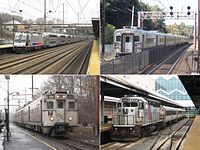
New Jersey Transit Corporation, branded as NJ Transit, and often shortened to NJT, is a state-owned public transportation system that serves the US state of New Jersey, along with portions of New York State and Pennsylvania. It operates bus, light rail, and commuter rail services throughout the state, connecting to major commercial and employment centers both within the state and in the adjacent major cities of New York and Philadelphia. In 2021, the system had a ridership of 133,463,800.

The Delaware, Lackawanna and Western Railroad was a U.S. Class 1 railroad that connected Buffalo, New York, and Hoboken, New Jersey, a distance of 395 miles (636 km). Incorporated in Pennsylvania in 1853 primarily for the purpose of providing a connection between the anthracite coal fields of Pennsylvania's Coal Region and the large markets for coal in New York City. The railroad gradually expanded both East and West, eventually linking Buffalo with New York City.

The Main Line is a commuter rail line owned and operated by New Jersey Transit running from Suffern, New York to Hoboken, New Jersey, in the United States. It runs daily commuter service and was once the north–south main line of the Erie Railroad. It is colored yellow on NJ Transit system maps, and its symbol is a water wheel.
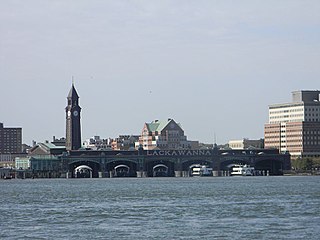
Hoboken Terminal is a commuter-oriented intermodal passenger station in Hoboken, Hudson County, New Jersey, United States. One of the New York metropolitan area's major transportation hubs, it is served by nine NJ Transit (NJT) commuter rail lines, one Metro-North Railroad line, various NJT buses and private bus lines, the Hudson–Bergen Light Rail, the Port Authority Trans Hudson (PATH) rapid transit system, and NY Waterway-operated ferries. More than 50,000 people use the terminal daily, making it the ninth-busiest railroad station in North America and the sixth-busiest in the New York area. It is also the second-busiest railroad station in New Jersey, behind only Newark Penn Station, and its third-busiest transportation facility, after Newark Liberty International Airport and Newark Penn Station. Hoboken Terminal is wheelchair-accessible, with high-level platforms for light rail and PATH services and portable lifts for commuter rail services.

For the purposes of this article, the Jersey City area extends North to Edgewater, South to Bayonne and includes Kearny Junction and Harrison but not Newark. Many routes east of Newark are listed here.

Maplewood is a train station that serves New Jersey Transit's Morristown Line and Gladstone Branch in the township of Maplewood, Essex County, New Jersey. Located in downtown Maplewood at 145 Dunnell Road, the station services trains from New York Penn Station and Hoboken Terminal to the east along with trains to Summit, Dover, Hackettstown and Gladstone to the west.

Dover is an NJ Transit station in Dover, Morris County, New Jersey, United States. The station was originally built by the Delaware, Lackawanna and Western Railroad in 1901 and was placed on the National Register of Historic Places in 1980.

Hackettstown is a New Jersey Transit station in Hackettstown, New Jersey. The station is located at the intersection of Valentine Street and Beatty Street and is the western terminus of the Morristown Line and the Montclair-Boonton Line, which both provide service to Hoboken Terminal or to Pennsylvania Station in Midtown Manhattan via Midtown Direct. Hackettstown station is the only active New Jersey Transit station in Warren County. The line from Hackettstown – Dover is diesel powered, requiring a transfer at Dover, Montclair State University or Newark Broad Street to an electrified train to New York Penn Station. Proposals exist of an extension of the Montclair-Boonton Line, including an extension to Washington and possibly Phillipsburg further along the Washington Secondary.

Lyons is a New Jersey Transit station in Basking Ridge, New Jersey along the Gladstone Branch of the Morris & Essex Lines. The station serves south Basking Ridge as well as the Hills and Liberty Corner.

Boonton is a NJ Transit station in Boonton, Morris County, New Jersey, United States along the Montclair-Boonton Line.
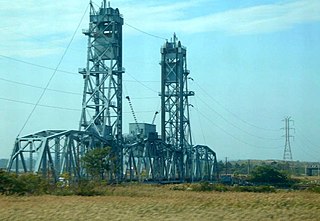
Upper Hack Lift is a lift bridge carrying the New Jersey Transit Main Line across the Hackensack River at mile 6.9 between Secaucus, New Jersey and Lyndhurst.

Bergen Hill refers to the lower Hudson Palisades in New Jersey, where they emerge on Bergen Neck, which in turn is the peninsula between the Hackensack and Hudson Rivers, and their bays. In Hudson County, it reaches a height of 260 feet.
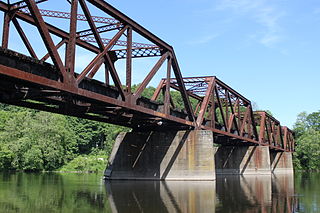
The Lackawanna Old Road was part of the original mainline of the Delaware, Lackawanna & Western Railroad (DL&W). Opened in 1856, it was for a half-century a part of the line connecting the states of New Jersey and Pennsylvania. In 1911, the DL&W cut 11 miles (18 km) off the route by opening the Lackawanna Cut-Off, which branched off from existing track at the new Port Morris Junction and Slateford Junction. The 39.6-mile (63.7 km) stretch of existing track between these junctions was relegated to secondary status and became known as the "Old Road".

The Binghamton was a ferryboat that transported passengers across the Hudson River between Manhattan and Hoboken from 1905 to 1967. Moored in 1971 at Edgewater, Bergen County, New Jersey, United States, the ship was operated as a floating restaurant from 1975 to 2007. In 2017, following ten years of damage that effectively rendered the boat unrestorable, the ferry was dismantled. No structural components were salvaged.

Roseville Tunnel is a 1,024-foot (312 m) two-track railroad tunnel on the Lackawanna Cut-Off in Byram Township, Sussex County, New Jersey. The tunnel is on a straight section of railroad between mileposts 51.6 and 51.8 (83 km), about 6 miles (9.7 km) north by northwest of Port Morris Junction. Operated for freight and passenger service from 1911 to 1979, it is undergoing work intended to return it to passenger service by 2026.

The Newark Drawbridge, also known as the Morristown Line Bridge, is a railroad bridge on the Passaic River between Newark and Harrison, New Jersey. The swing bridge is the 11th bridge from the river's mouth at Newark Bay and is 5.85 miles (9.41 km) upstream from it. Opened in 1903, it is owned and operated by New Jersey Transit.

The Lyndhurst Draw is a railroad bridge crossing the Passaic River between Clifton and Lyndhurst in northeastern New Jersey. Built in 1903, it is owned and operated by New Jersey Transit Rail Operations (NJT).
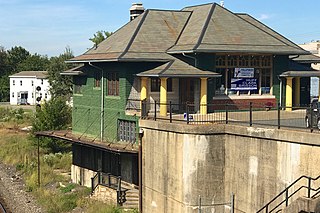
Phillipsburg Union Station is an inactive railroad station in Phillipsburg, New Jersey, United States, at 178 South Main Street. Opened in 1914, Union Station was built by the Delaware, Lackawanna & Western Railroad (DL&W) and shared with the Central Railroad of New Jersey (CNJ) and was situated where the lines merged before the bridge crossing the Delaware River. Designed by Frank J. Nies, the architect who produced many of DL&W stations now listed state and federal registers of historic places, the 2 1/2 story, 3 bay brick building is unusual example of a union station and a representation of early 20th century Prairie style architecture. The Phillipsburg Union Signal Tower, or PU Tower, is nearby.
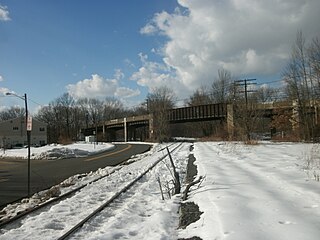
Mountain View was a station on the Boonton Branch of the Delaware, Lackawanna and Western Railroad. Located in the Mountain View section of Wayne Township, New Jersey, the station was at the Parish Drive bridge over the tracks. The station was 20.8 miles (33.5 km) away from its terminus at Hoboken Terminal on the shores of the Hudson River, where connections would be made to New York City via ferry and the Hudson and Manhattan Railroad. The western terminus. Denville, was 12.8 miles (20.6 km) away, where connections with the Morris and Essex Railroad were available. Just west of the station was Mountain View junction, where a connection was made to the Erie Railroad's New York and Greenwood Lake Railway was made.
























